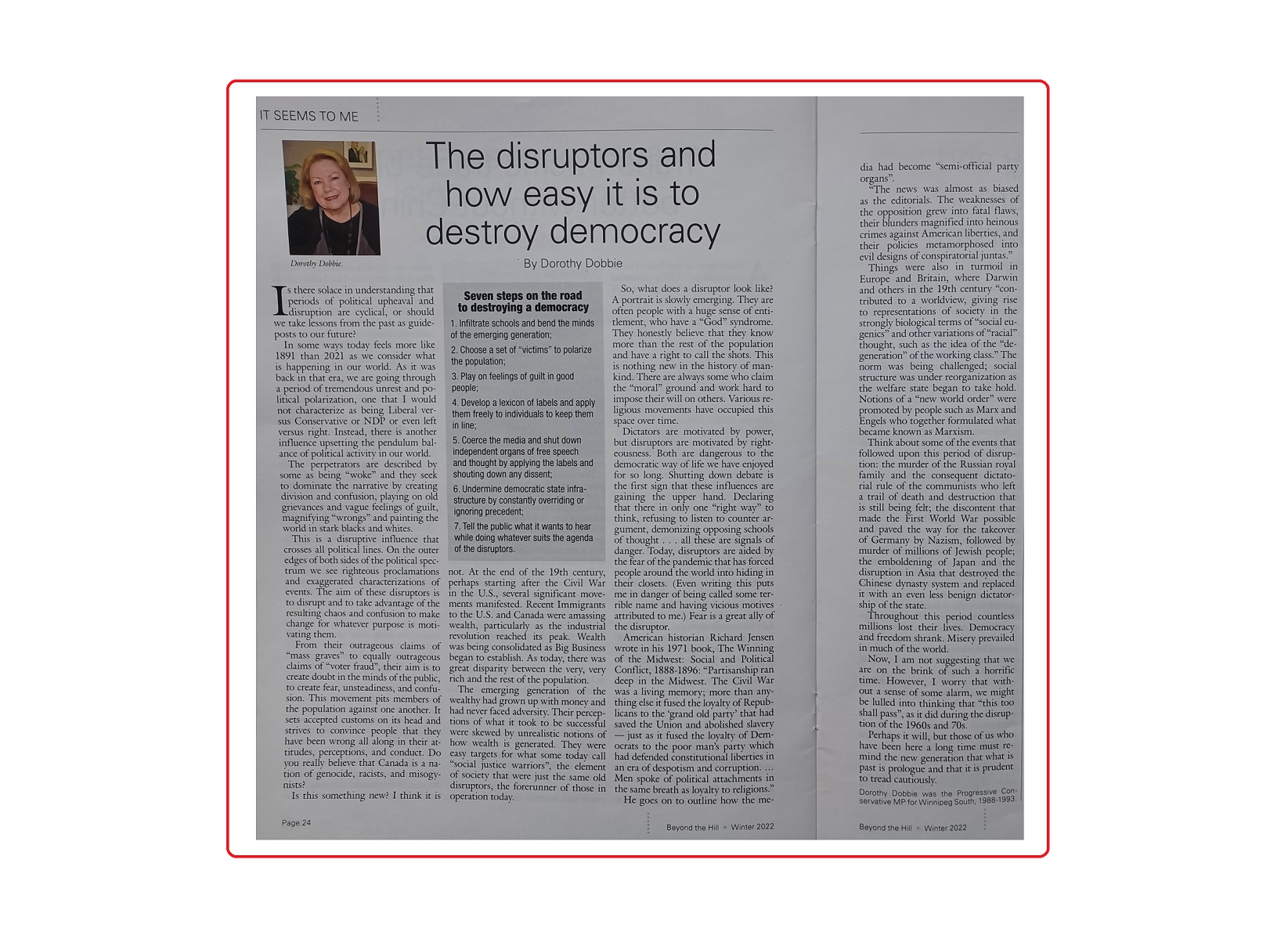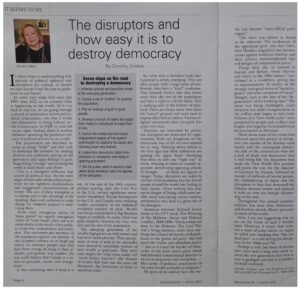The disruptors and how easy it is to destroy democracy
TORONTO – Is there solace in understanding that periods of political upheaval and disruption are cyclical, or should we take lessons from the past as guideposts to our future?
In some ways today feels more like 1891 than 2021 as we consider what is happening in our world. As it was back in that era, we are going through a period of tremendous unrest and political polarization, one that I would not characterize as being Liberal versus Conservative or NDP or even left versus right.
Instead, there is another influence upsetting the pendulum balance of political activity in our world. The perpetrators are described by some as being “woke” and they seek to dominate the narrative by creating division and confusion, playing on old grievances and vague feelings of guilt, magnifying “wrongs” and painting the world in stark blacks and whites.
This is a disruptive influence that crosses all political lines. On the outer edges of both sides of the political spectrum we see righteous proclamations and exaggerated characterizations of events. The aim of these disruptors is to disrupt and to take advantage of the resulting chaos and confusion to make change for whatever purpose is motivating them.
From their outrageous claims of “mass graves” to equally outrageous claims of “voter fraud”, their aim is to create doubt in the minds of the public, to create fear, unsteadiness, and confusion. This movement pits members of the population against one another. It sets accepted customs on its head and strives to convince people that they have been wrong all along in their attitudes, perceptions, and conduct.
Do you really believe that Canada is a nation of genocide, racists, and misogynists? Is this something new? I think it is not.
At the end of the 19th century, perhaps starting after the Civil War in the U.S., several significant movements manifested. Recent Immigrants to the U.S. and Canada were amassing wealth, particularly as the industrial revolution reached its peak. Wealth was being consolidated as Big Business began to establish. As today, there was great disparity between the very, very rich and the rest of the population. The emerging generation of the wealthy had grown up with money and had never faced adversity. Their perceptions of what it took to be successful were skewed by unrealistic notions of how wealth is generated.
They were easy targets for what some today call “social justice warriors”, the element of society that were just the same old disruptors, the forerunner of those in operation today.
So, what does a disruptor look like? A portrait is slowly emerging. They are often people with a huge sense of entitlement, who have a “God” syndrome. They honestly believe that they know more than the rest of the population and have a right to call the shots. This is nothing new in the history of mankind. There are always some who claim the “moral” ground and work hard to impose their will on others.
Various religious movements have occupied this space over time. Dictators are motivated by power, but disruptors are motivated by righteousness. Both are dangerous to the democratic way of life we have enjoyed for so long. Shutting down debate is the first sign that these influences are gaining the upper hand.
Declaring that there in only one “right way” to think, refusing to listen to counter argument, demonizing opposing schools of thought … all these are signals of danger.
Today, disruptors are aided by the fear of the pandemic that has forced people around the world into hiding in their closets. (Even writing this puts me in danger of being called some terrible name and having vicious motives attributed to me.) Fear is a great ally of the disruptor.
American historian Richard Jensen wrote in his 1971 book, The Winning of the Midwest: Social and Political Conflict, 1888-1896: “Partisanship ran deep in the Midwest. The Civil War was a living memory; more than anything else it fused the loyalty of Republicans to the ‘grand old party’ that had saved the Union and abolished slavery – just as it fused the loyalty of Democrats to the poor man’s party which had defended constitutional liberties in an era of despotism and corruption.
Men spoke of political attachments in the same breath as loyalty to religions.” He goes on to outline how the media had become “semi-official party organs”.
“The news was almost as biased as the editorials. The weaknesses of the opposition grew into fatal flaws, their blunders magnified into heinous crimes against American liberties, and their policies metamorphosed into evil designs of conspiratorial juntas.”
Things were also in turmoil in Europe and Britain, where Darwin and others in the 19th century “contributed to a worldview, giving rise to representations of society in the strongly biological terms of ”social eugenics” and other variations of “racial” thought, such as the idea of the “degeneration” of the working class.”
The norm was being challenged; social structure was under reorganization as the welfare state began to take hold.
Notions of a “new world order” were promoted by people such as Marx and Engels who together formulated what became known as Marxism. Think about some of the events that followed upon this period of disruption: the murder of the Russian royal family and the consequent dictatorial rule of the communists who left a trail of death and destruction that is still being felt; the discontent that made the First World War possible and paved the way for the takeover of Germany by Nazism, followed by murder of millions of Jewish people; the emboldening of Japan and the disruption in Asia that destroyed the Chinese dynasty system and replaced it with an even less benign dictatorship of the state.
Throughout this period, countless millions lost their lives. Democracy and freedom shrank. Misery prevailed in much of the world. Now, I am not suggesting that we are on the brink of such a horrific time. However, I worry that without a sense of some alarm, we might be lulled into thinking that “this too shall pass”, as it did during the disruption of the 1960s and 70s. Perhaps it will, but those of us who have been here a long time must remind the new generation that what is past is prologue and that it is prudent to tread cautiously.
Seven steps on the road to destroying a democracy
1. Infiltrate schools and bend the minds of the emerging generation;
2. Choose a set of “victims” to polarize the population;
3. Play on feelings of guilt in good people;
4. Develop a lexicon of labels and apply them freely to individuals to keep them in line;
5. Coerce the media and shut down independent organs of free speech and thought by applying the labels and shouting down any dissent;
6. Undermine democratic state infrastructure by constantly overriding or ignoring precedent;
7. Tell the public what it wants to hear while doing whatever suits the agenda of the disruptors.
Dorothy Dobbie
Dorothy Dobbie was the Progressive Conservative MP for Winnipeg South, 1988-1993
Article reproduced with permission from Beyond the Hill, magazine of Canadian Association of Former Parliamentarians





